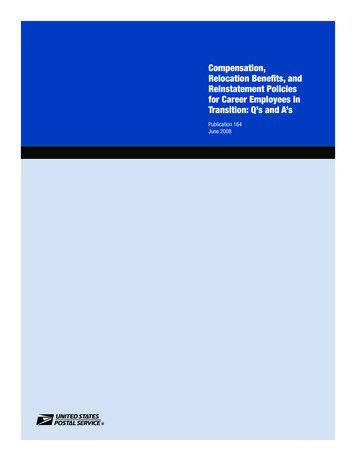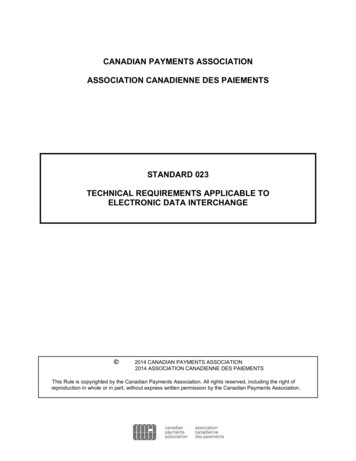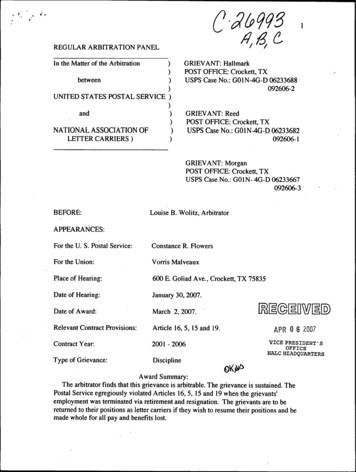
Transcription
Compensation,Relocation Benefits, andReinstatement Policiesfor Career Employees inTransition: Q’s and A’sPublication 164June 2008
ContentsIntroduction. . . . . . . . . . . . . . . . . . . . . . . . . . . . . . . . . . 1Managing Your Benefits Online. . . . . . . . . . . . . . . . . . . 2Change to a Lower-Level Position . . . . . . . . . . . . . . . . 3Severance Pay and DiscontinuedService Annuity . . . . . . . . . . . . . . . . . . . . . . . . . . . . . 4Pay for Performance. . . . . . . . . . . . . . . . . . . . . . . . . . . 10Health Insurance. . . . . . . . . . . . . . . . . . . . . . . . . . . . . . 11Life Insurance . . . . . . . . . . . . . . . . . . . . . . . . . . . . . . . . 14Leave. . . . . . . . . . . . . . . . . . . . . . . . . . . . . . . . . . . . . 16Thrift Savings Plan . . . . . . . . . . . . . . . . . . . . . . . . . . . . 17Flexible Spending Accounts . . . . . . . . . . . . . . . . . . . . . 21Commuter Program. . . . . . . . . . . . . . . . . . . . . . . . . . . . 22Relocation Benefits . . . . . . . . . . . . . . . . . . . . . . . . . . . 23Unemployment Compensation . . . . . . . . . . . . . . . . . . 25Reinstatement. . . . . . . . . . . . . . . . . . . . . . . . . . . . . . . . 26Rehire or Transfer . . . . . . . . . . . . . . . . . . . . . . . . . . . . . 28Publication 164, June 2008i
IntroductionTo meet the demands of an ever-changing marketplace, corporationsperiodically make changes to their organizations. These organizationalchanges are part of the normal life cycle of a business. The response ofthe Postal Service to marketplace demands is reflected in its StrategicTransformation Plan 2006–2010. The Plan specifies goals for enabling thePostal Service to: Carry out its long-standing mission of providing affordable universalservice.Prepare the organization for the challenges of change in a dynamicmarketplace.Organizational changes that eliminate work can result in one or more ofthe following: The need for fewer authorized positions. Elimination of organizations. Closing of facilities.These kinds of changes may affect you and your family — bothfinancially and personally.The Postal Service recognizes the contribution you have made to achievethese goals and is committed to making your transition as smooth aspossible. This publication provides an overview of the benefits you maybe entitled to — whether you stay with the Postal Service or are facedwith an involuntary separation. The question-and-answer format providesan overview of the various compensation and benefit programs availableto career Postal Service employees. For additional information, call theHuman Resources Shared Services Center, toll-free, at877-477-3273, and select option 5.Note: This brochure is intended only as an overview of compensation,relocation benefits, and reinstatement policies for career employees.Policies and regulations governing these programs are provided invarious Postal Service manuals and handbooks. Several of theseprograms are governed by federal law and regulations issued by theU.S. Office of Personnel Management. The scope and level of benefitsprovided by many of these programs are subject to the collectivebargaining process and are defined in the applicable collectivebargaining agreement.Publication 164, June 20081
Managing Your Benefits OnlineMany of the benefits and options discussed in this publicationcan be managed via the Internet, as follows:Office of Personnel Management (OPM)http://www.opm.gov/retire/This Web site provides publications and forms, resources forretirement planning, and links to other useful organizations.Federal Employees Health Benefits (FEHB) Programhttp://www.opm.gov/insure/health/Get detailed information on topics such as: Benefits available to retirees, survivor annuitants, and formerspouses. Temporary Continuation of Coverage (TCC). Premiums.View and print plan brochures, plan provider directories, andStandard Form (SF), Health Benefits Election Form.Federal Employees’ Group Life Insurance (FEGLI) Programhttp://www.opm.gov/insure/life/Get detailed information about topics such as premiums forannuitants and designation of beneficiaries. View and printpublications and forms such as: RI 76-12, Information for Retirees and Their Families. SF 2818, Continuation of Life Insurance. SF 2823, Designation of Beneficiary.Thrift Savings Plan (TSP)http://www.tsp.gov/View and print publications and forms, learn about the TSP funds,and use a calculator to project your annuity.http://www.tsp.gov/account/Access your account balance and request certain transactions.To access your account, use your Social Security number and an8-character password.Publication 164, June 20082
Change to a Lower-Level Position1As a nonbargaining employee, whathappens to my grade and salary if Ivoluntarily elect to change to alower-level position?When the Postal Service activates its reduction in force (RIF)avoidance procedures, this is what happens: If you are voluntarily placed into a lower-grade position, youwill retain your current grade for 2 years. After that time, youwill receive the grade of the lower-level position, but you willbe eligible for “indefinite protected salary.”While covered under the “saved grade” provision you mayreceive pay-for-performance lump-sum payments based onyour saved grade.After 2 calendar years you will be placed into the lower-levelposition. If your salary is: 2Within the range of the lower-level position, no furtheraction is necessary.Above the maximum of the new lower-level position, youwill receive indefinite saved salary. However, your pay-forperformance increase or lump sum will be based on thelower-level position.What is saved grade?Saved grade means that you continue to be paid at the grade youformerly held. Your saved grade pay is supplemented by generalincreases and premium pay to include the night differential,Sunday premium pay, and Territorial Cost-of-Living Allowance (inaccordance with Postal Service policies and collective bargainingunit contracts).3What is indefinite protected salary fornonbargaining employees?Indefinite protected salary means that if your current salary doesnot fall into the salary range of the lower-level position, you willretain your current salary for as long as you occupy the lowerlevel position. While covered under the saved salary provision,you will be eligible for pay-for-performance lump-sum paymentsuntil the salary maximum of the lower-level position exceedsyour current saved salary according to the policies applicable toemployees at or above the maximum salary of their grade.Publication 164, June 20083
4What salary protection is available forbargaining unit employees?Bargaining unit employees who voluntarily decide to acceptlower-level positions do not receive rate protection. They are paidaccording to the grade and step of their job, as determined by thesalary schedule in effect at the time they accept the lower-levelposition. As a bargaining unit employee involuntarily placed into alower-grade position, you will receive “saved grade” until you failto bid or apply for a position in your former grade.For exceptions to saved grade, see the Employee and LaborRelations Manual (ELM), part 421.531.Severance Pay and DiscontinuedService Annuity5Will I be entitled to severance pay or adiscontinued service annuity?OverviewLimitationsIf you voluntarily resign from the Postal Service, you are notentitled to severance pay or a discontinued service annuity,except as specified under “Discontinued Service Annuity” onpage 6. In addition: If you are eligible for a discontinued service annuity, you areautomatically disqualified from receiving severance pay.You are never entitled to receive both severance pay and adiscontinued service annuity.Bargaining EmployeesYou may be entitled to severance pay or a discontinued serviceannuity if you receive an involuntarily separation due to a layoff orreduction-in-force under the terms of Article 6 of your collectivebargaining agreement.Bargaining employees impacted by involuntary reassignmentsoutside of their local commuting area under Article 12 of theircollective bargaining agreement may be entitled to a discontinuedservice annuity if they meet Office of Personnel Managementrequirements. However, they are not entitled to severance pay.Publication 164, June 20084
To determine your eligibility for a discontinued service annuity orseverance pay, contact the Human Resources Shared ServiceCenter (HRSSC) at one of the following:HRSSC1-877-477-3273, option 5HRSSC eBluehttp://liteblue.usps.govNonbargaining EmployeesIf you are a nonbargaining employee, you may be entitledto severance pay or a discontinued service annuity if yourinvoluntary separation is due to either of the following: You lost your job as a result of a RIF.You declined a directed reassignment outside yourcommuting area.Note: If you voluntarily resign before the effective date of aninvoluntary separation notice, you retain eligibility for severancepay or discontinued service retirement.Severance PayIf you have been employed continuously by the Postal Serviceor another federal agency as a civilian for at least 12 consecutivemonths immediately before your separation, you are eligible forseverance pay, unless you are: Immediately eligible for a retirement annuity, including adiscontinued service annuity or FERS – MRA 10(see exhibit 6).Offered and decline a position of like seniority, tenure, and paywith the Postal Service or another federal agency within yourcommuting area.Receiving compensation at the time of separation as abeneficiary of the Federal Employees Compensation Act(Injury Compensation). However if you are receiving thiscompensation concurrently with Postal Service pay, yourseverance pay is based only on your Postal Service pay.Separated because you entered military service.Separated for cause on charges of misconduct, delinquency,or inefficiency.Publication 164, June 20085
If you are found eligible, a severance pay fund is established foryou. The amount is determined as follows: It is based on 1 week of basic salary for each year ofcreditable service up to 10 years, plus 2 weeks of basic salaryfor each year of creditable service in excess of 10 years.Each 3-month period of service that exceeds 1 or more fullyears of service is computed as 25 percent of a full year.The basic severance pay allowance is increased by 10percent for each year that your age exceeds 40 years at thetime of separation.Your total severance pay fund cannot exceed 52 weeks ofyour basic salary.You receive severance pay on a pay-period basis in the amountof 2 times your basic weekly salary, less withholdings, until theseverance pay fund is exhausted or you are reemployed by thePostal Service or another federal agency.Discontinued Service AnnuityOffice of Personnel Management (OPM) requirements forreceiving a discontinued service annuity are discussed in theparagraphs that follow. If you meet all of the following conditions,you may be eligible for an immediate, possibly reduced,discontinued service annuity.Minimum Age and Service RequirementsYou must be either of the following: At least age 50 with at least 20 years of creditable service.Any age with at least 25 years of creditable service as of theeffective date of your involuntary separation.Other requirements: Your creditable service must include at least 5 years of civilianservice.Your accrued and unused annual leave or donated leave maybe used to meet either the age or service-years requirementto qualify for a discontinued service retirement.You may be placed on approved annual leave beyond theeffective date of the involuntary separation notice so thatyou may use enough leave to satisfy the age or service-yearsrequirement.Publication 164, June 20086
Your remaining annual leave balance, if any, will be paid in aterminal leave payment.You may not use sick leave to meet minimum age and servicerequirements.Separation From Covered PositionYou must be separated from a position that is covered by the CivilService Retirement System (CSRS), CSRS Offset, or the FederalEmployees Retirement System (FERS).The “1-out-of-2” Requirement Under CSRSIf you are covered by CSRS or CSRS Offset, you must have beensubject to retirement contributions for at least 1 year within the2-year period immediately preceding the separation upon whichthe annuity is based. The year of service does not have to becontinuous. (This requirement does not apply if you are coveredby FERS.)Reasonable OfferIf you refuse a reasonable offer of another position, you willnot qualify for a discontinued service annuity. For discontinuedservice annuity purposes, a job offer is considered reasonable ifthe following requirements are met: The offer is made in writing. You meet the qualifications for the position being offered. The position offered is: Within your local commuting area; Within the same tenure group (career or noncareer); Within the same work schedule (full time or part time); and Not more than the equivalent of two grade or pay levelsbelow your current grade or pay level.Annuity AmountThe amount of your annuity is determined as follows: If you are a CSRS or CSRS Offset employee, your annuitywill be computed using voluntary optional retirement annuitycalculations based on total creditable years and months ofservice and average high-3 salary. If you are under age 55,your annuity will be reduced at the rate of 2 percent a year,or by 1/6 of 1 percent for each full month that
Publication 164, June 2008 1 Introduction To meet the demands of an ever-changing marketplace, corporations periodically make changes to their organizations .











